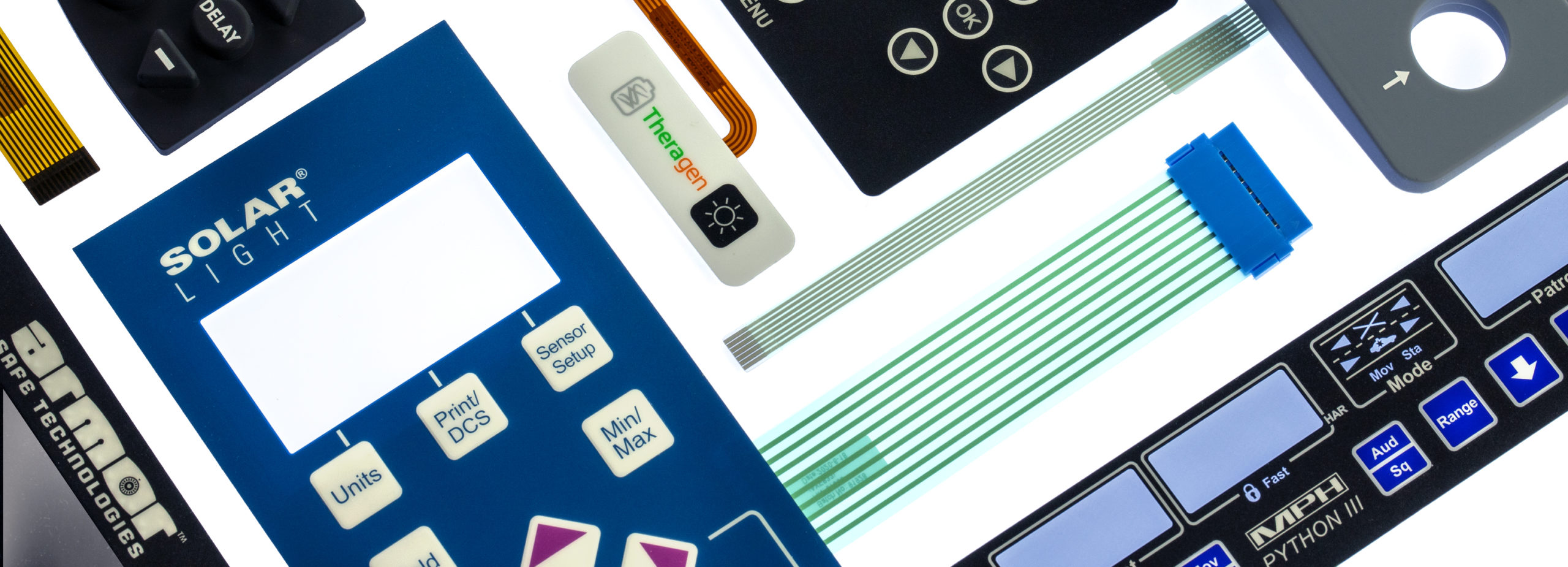Explore the Benefits of Using a Membrane Switch in Modern Devices
Explore the Benefits of Using a Membrane Switch in Modern Devices
Blog Article
Comprehending Membrane Layer Changes: The Trick to Resilient and Dependable Controls

What Are Membrane Buttons?
Membrane layer buttons are an innovative solution in the realm of interface innovation, integrating performance and layout flawlessly. These tools offer as a user interface in between customers and digital systems, incorporating numerous parts right into a portable layout. Typically constructed from flexible, thin layers of products, membrane layer buttons are created to react to touch, allowing customers to communicate with equipment and electronic gadgets properly.
The primary aspects of a membrane layer button consist of a published circuit layer, graphic overlay, and a spacer layer that avoids unintentional activation. The graphic overlay can be tailored to mirror brand name identity or user choices, improving aesthetics while ensuring use. Membrane layer switches are typically utilized in numerous applications, consisting of clinical gadgets, consumer electronic devices, and commercial devices, owing to their sturdiness and resistance to ecological elements such as dampness and dirt.
One of the vital advantages of membrane buttons is their capability to withstand deterioration, making them optimal for high-traffic environments. In addition, they are lightweight and require marginal space, enabling for innovative layouts in product growth. In general, membrane layer changes stand for a effective and practical option for modern electronic user interfaces, marrying modern technology with user-centric design concepts.
How Membrane Layer Switches Over Work
The procedure of membrane changes joints on an easy yet reliable mechanism that equates user input into digital signals. These buttons consist of numerous layers, generally consisting of a visuals overlay, a spacer layer, and a circuit layer. When an individual presses the button, the leading layer deforms, enabling a conductive component in the circuit layer to make contact with a matching conductive pad on the bottom of the graphic overlay. This get in touch with shuts the circuit and sends out an electronic signal to the gadget, showing that the switch has been triggered.
The style of membrane layer buttons can vary, but they commonly include domes or responsive components to provide feedback to the individual, improving the total experience - membrane switch. The products made use of in membrane layer buttons, such as polyester or polycarbonate, add to their toughness and resistance to environmental aspects, consisting of wetness and dirt. The printed circuits are generally encapsulated, which protects them from wear and tear over time.
Advantages of Membrane Layer Buttons

Additionally, membrane switches are known for their sturdiness. Created from durable products, they are immune article to dirt, dampness, and physical wear, which dramatically expands their lifespan contrasted to traditional mechanical switches. This resilience makes them particularly suitable for high-traffic environments and applications requiring longevity.
Another significant advantage is the convenience of cleansing and upkeep. The smooth surface of membrane switches minimizes dirt buildup and is usually resistant to spills, making them excellent for setups that need regular sanitization.
Furthermore, membrane buttons supply a structured profile, leading to a thinner design that can be incorporated into various devices without including bulk. This feature not just improves the aesthetic appeal yet likewise adds to a more ergonomic item style.
Applications of Membrane Buttons
Straightforward and flexible, membrane buttons find applications across a wide variety of markets, consisting of medical tools, customer electronics, and commercial equipment. In the clinical field, these buttons are important to devices such as analysis equipment, person tracking systems, and mixture pumps, where dependability and convenience of cleaning are critical. Their capacity to preserve and hold up against severe settings functionality view website makes them excellent for such applications.

In customer electronics, membrane layer buttons are used in items like microwaves, Read More Here cleaning machines, and push-button controls - membrane switch. Their streamlined design permits instinctive interface, improving the general customer experience while providing toughness and resistance to put on and tear
Industrial devices additionally profits from membrane switches, especially in control panels for equipment and automation systems. These buttons supply protection against dust and wetness, making certain regular performance in challenging atmospheres. In addition, their customizable features enable makers to customize them to details functional demands, boosting performance and functionality.
Choosing the Right Membrane Switch
When selecting a membrane button, it is crucial to take into consideration numerous variables that affect performance and suitability for specific applications. The key factors to consider consist of environmental conditions, responsive comments, toughness, and style specs.
First, evaluate the operating environment; buttons revealed to wetness, chemicals, or extreme temperatures need details products to make certain long life and performance. Next, review the requirement for tactile feedback. Depending upon customer interaction, some applications may gain from a tactile response to validate activation, while others may favor a non-tactile style for aesthetic factors.
Sturdiness is another critical aspect; membrane buttons ought to be made to stand up to frequent usage, impacts, and abrasion. Make sure the selected button can endure the anticipated lifecycle, particularly in high-usage situations.

Conclusion
In final thought, membrane layer switches over serve as necessary parts in the design of long lasting and reliable control systems across various markets. The adaptability of membrane layer switches enables for customized options that fulfill specific operational requirements, strengthening their relevance in modern-day innovation.
Membrane layer switches over represent a crucial element of contemporary user interface style, mixing capability with strength in numerous applications.Membrane layer buttons are an innovative solution in the realm of customer interface modern technology, combining functionality and design seamlessly. Usually built from versatile, thin layers of materials, membrane switches are made to react to touch, making it possible for customers to communicate with machinery and digital tools properly.
The layout of membrane layer switches can vary, but they often incorporate domes or responsive components to supply comments to the user, enhancing the total experience.In verdict, membrane layer changes serve as crucial parts in the style of resilient and dependable control systems throughout different industries.
Report this page